Mastering the Art of Sautéing Meat: A Step-by-Step Guide
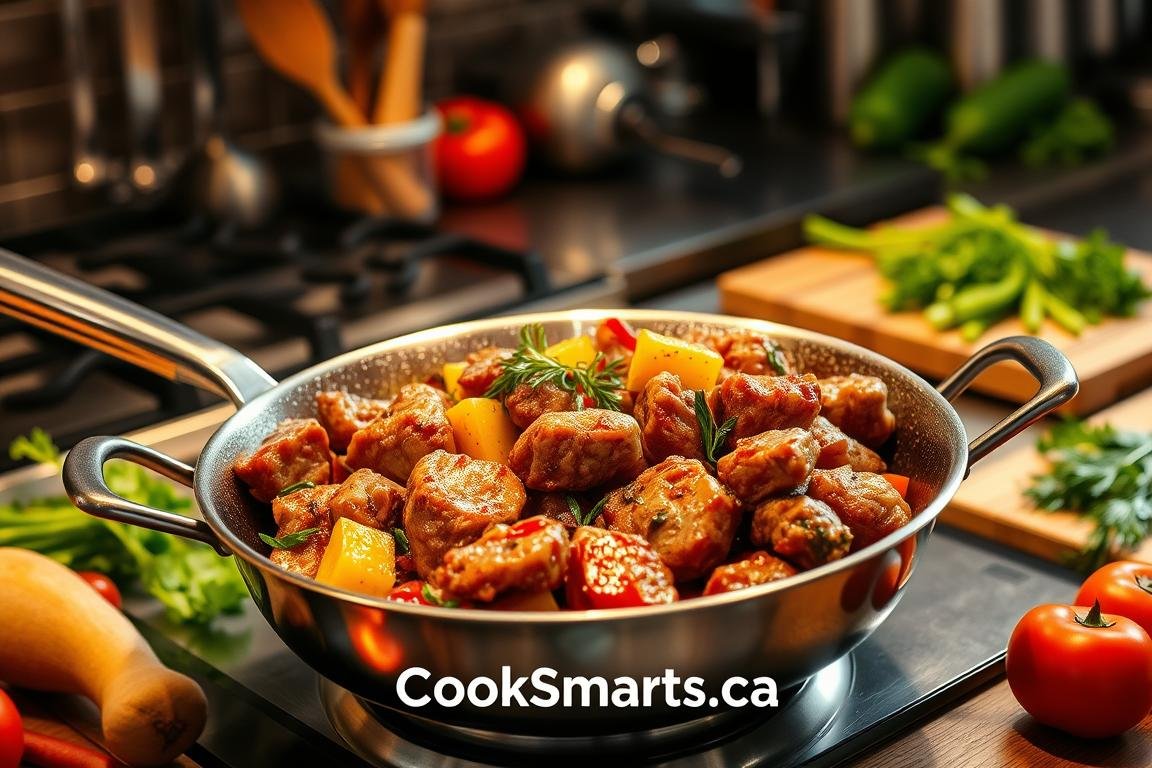
Discover the secrets of professional chefs with this guide to mastering the art of sautéing meat. It’s perfect for both experienced cooks and new food lovers. Sautéing is more than just heating meat in a pan. It’s a blend of heat, timing, and method that transforms basic cuts into delicious meals.
Entering the high-heat cooking scene requires skill, like that of an artist, and precise timing. This guide will help you master meat preparation. Soon, you’ll be making juicy, tasty dishes in no time.
Key Takeaways
- Understanding the right cookware and when to use a 10” stainless steel fry pan, the all-star of sautéing.
- Choosing the proper oils with high smoke points to ensure your meat doesn’t just cook, but sings with flavor.
- Prepping your meat by cutting it into uniform pieces for even sautéing.
- The art of not overcrowding the pan, crucial for achieving that perfect sear.
- Learning the fine line between flipping for even cooking and over-stirring, which could cost the texture and taste of your dish.
- Appreciating the subtle difference between sautéing and stir-frying that can make or break a dish.
- Recognizing the importance of temperature control and attentive cooking to sauté meat to perfection.
What is Sautéing and Why It Matters
Sautéing is a simple yet refined cooking technique. It’s known for quickly cooking small or thin pieces of food with high heat. This method makes meals flavorful and keeps their texture just right. By understanding sautéing, its benefits, and common mistakes, you can improve your cooking.
Defining Sautéing
Sautéing means cooking food fast in a little oil or fat over high heat. It’s great for getting food crispy on the outside but keeping it moist inside. It’s different from searing or pan-frying because it uses less oil. Sometimes, liquids like broth or wine are added. This helps build flavor through a process called deglazing.
Benefits of Sautéing Meat
Sautéing boosts flavor through the Maillard reaction. This happens when meat browns, creating deep flavors and aromas. It’s a quick and healthy way to cook, using less oil than frying. This makes it a top choice for those cutting down on fat. Also, sautéing works with many meats and veggies. You can adjust it to fit your tastes and needs.
Common Mistakes to Avoid
When mastering sautéing, watch out for a few errors. Don’t cram your pan—this can cause food to steam instead of brown, which spoils texture and taste. Also, watch your heat carefully. Too hot, and food burns. Too low, and it won’t sear right. Stir and toss regularly for an even cook, but not too much. Too much stirring can stop food from browning well.
Make sure ingredients are dry and cut evenly. This helps them cook right and taste great.
Learning these sautéing tips can really boost your cooking skills. With practice, you’ll get even better at it. This means tastier dishes all around.
Essential Tools for Sautéing Meat
Having the right tools in your kitchen changes everything, especially with high-heat cooking like sautéing. Knowing the key cookware and utensils makes your sautéed meals tasty and well-cooked.
Recommended Cookware
A top-notch sauté pan is key for sautéing. Choose a pan that’s strong, well-balanced, and has a flat bottom. This helps heat spread evenly. Stainless steel pans are tough and handle high heat well.
For delicate meats like fish or chicken, nonstick pans are better. They prevent sticking. Make sure they are PFOA-free for your health when using them for high-heat cooking.
Utensils You’ll Need
You need a solid spatula for sautéing. Silicone spatulas are best because they don’t melt or warp at high temperatures. They also won’t scratch nonstick pans, helping them last longer. If you like classic tools, wooden spoons are another good choice. They’re strong but still gentle on pans.
Optional Gadgets
Some gadgets, while not necessary, can improve your cooking. A meat thermometer helps make sure meat is safely cooked. A timer or an oil sprayer can also help, the sprayer by using less oil but covering the pan well.
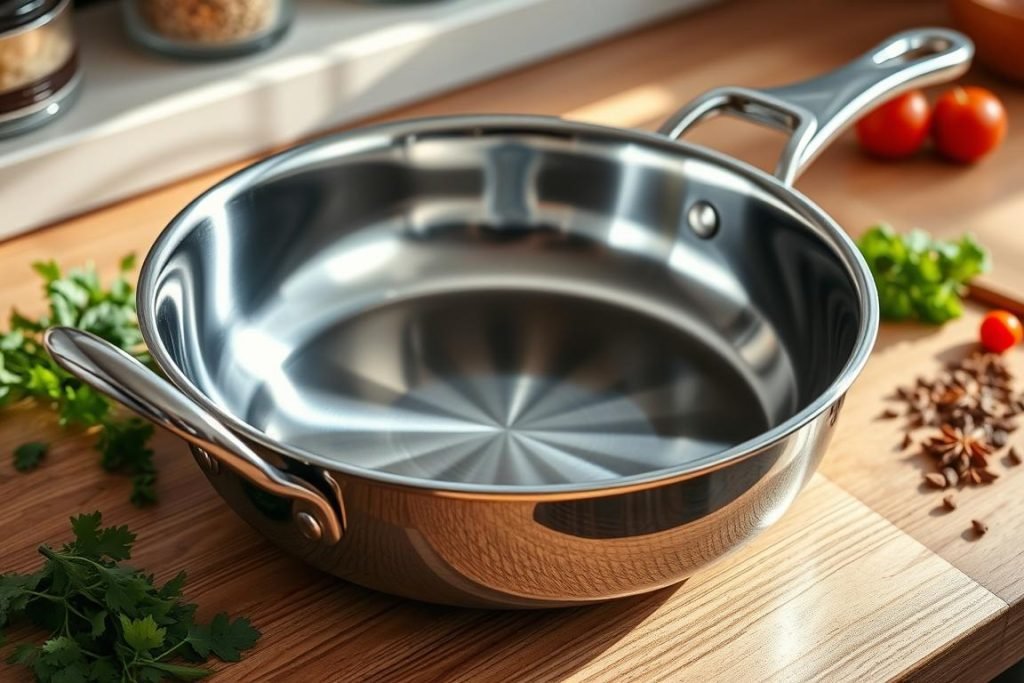
| Type of Tool | Description | Material |
|---|---|---|
| Sauté Pan | Flat bottom, ideal for quick heating and evaporation | Stainless Steel, Nonstick |
| Spatula | Heat resistant, non-abrasive to pans | Silicone |
| Meat Thermometer | Ensures meat reaches safe internal temperatures | Various |
By adding these tools to your kitchen, you’re ready to succeed at sautéing. No matter if you’re an experienced chef or just starting, the right sauté pan, spatula, and some handy gadgets can elevate your food.
Choosing the Right Cuts of Meat
Selecting great meat cuts for sautéing can make your dishes tastier and more tender. Knowing which cuts to use for sautéing ensures your meals will be delicious. This will give you great results every time.
Best Cuts for Sautéing
For sautéing, it’s important to pick tender, boneless cuts. The best choices include:
- Chicken tenderloin and breast, known for their leanness and quick cooking time.
- Beef tenderloin and sirloin, prized for their fine texture and minimal marbling.
- Pork tenderloin, which offers a succulent flavor when cooked quickly.
- Lamb chops, perfect for a quick sear to retain their juicy interior.
These cuts do well with the quick, high heat of sautéing. They stay tender and make your meals delightful.
How to Select Fresh Meat
For the best quality, choose meat that’s vibrant in color and firm. It shouldn’t smell bad and the package must be intact. Always check the sell-by dates to ensure it’s very fresh.
Importance of Marbling
Marbling means white fat spots within the meat. It is vital for more flavor and moisture in cuts like Ribeye and Tenderloin. The right amount of marbling keeps meat juicy and tasty, especially while sautéing.
| Cut Type | Best Cooking Method | Marbling Quality | % of Animal |
|---|---|---|---|
| Tenderloin (Beef) | Grilling, Pan-Searing | Minimal | — |
| Ribeye (Beef) | Grilling, Pan-Searing | Rich | — |
| Pork Loin | Roasting, Grilling | Low | — |
| Lamb Loin Chop | Grilled, Pan-Fried | Low to Moderate | — |
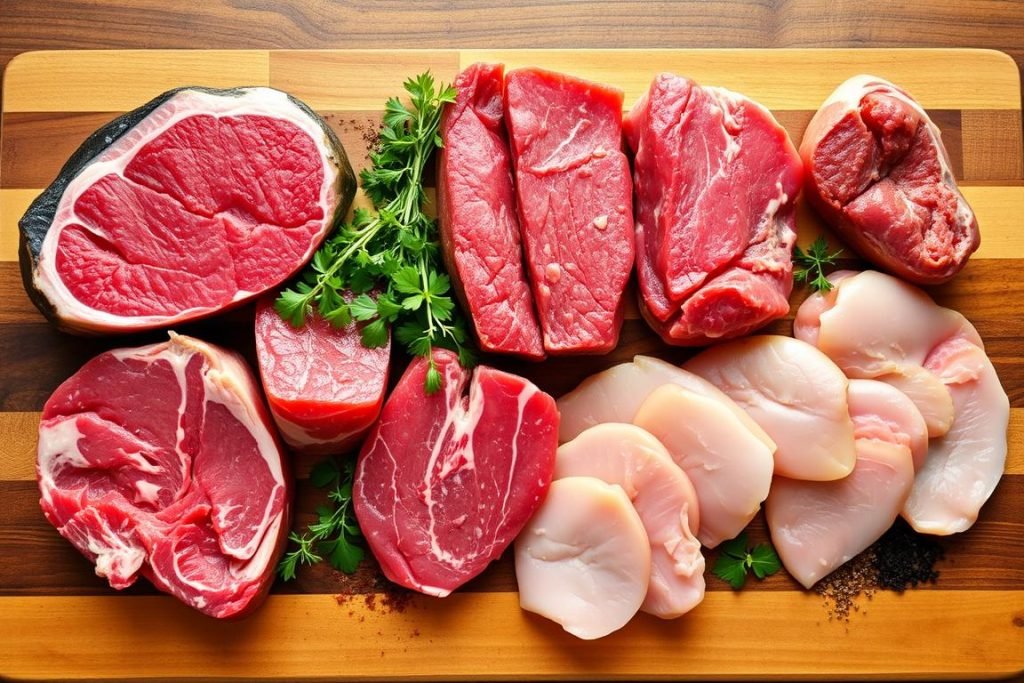
Keep in mind the cut, how fresh it is, and the marbling. Doing so will help you master sautéing. This will bring out the best flavors in your meat dishes.
Preparing Meat for Sautéing
Learning to prepare meat for sautéing boosts flavor and ensures it’s cooked just right. Before starting, you need to clean the meat, season it, and decide on marinating. These steps are key.
Cleaning and Trimming
Cleaning meat is more than a quick rinse. You must trim off extra fat and any parts that might hinder even cooking or texture. After trimming, always dry the meat well. This is because moisture stops the meat from browning well, which affects flavor.
Proper Seasoning Techniques
How you season your dish is crucial. Starting with quality salt and pepper is basic. Yet, adding herbs and spices meant for your meat can elevate its natural tastes. Properly seasoning meat, even without a marinade, makes it delicious just with heat.
Marinating vs. Non-Marinating
The choice to marinate meat or not varies with the protein and what you want in the end. Marinating is great for adding deep flavors and softening tougher meats. It uses acids or enzymes to make the meat tender. But, if you decide not to marinate, still season well and cook carefully to keep it moist and tasty.
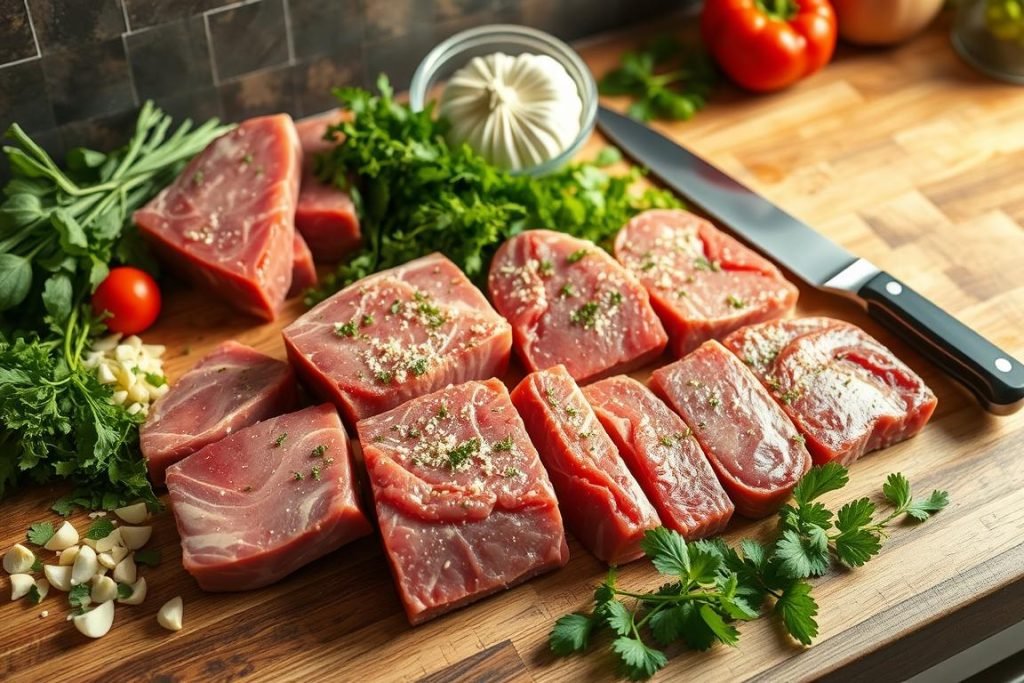
The Sautéing Process: Step-by-Step
Mastering the sautéing process is key to making meat that is juicy and flavorful. This guide will show you how to cook with high heat, choose the right oil, and perfect your skills in the kitchen.
Heating the Pan
To start, heat your pan properly. Use medium-high heat for stainless steel and medium for nonstick. Heating the pan first is important. It helps create a tasty crust on the meat.
Adding Oil: Types and Tips
It’s important to choose the right oil. Use oils like vegetable oil or clarified butter. They don’t burn easily. This keeps your meat’s flavor good. Just use enough oil to cover the pan’s bottom.
Cooking Techniques
Place the meat in the pan so there’s space around each piece. This helps it brown nicely. Don’t move the meat too soon. Wait until it’s golden on one side before flipping it. Then, cook it to how done you like it.
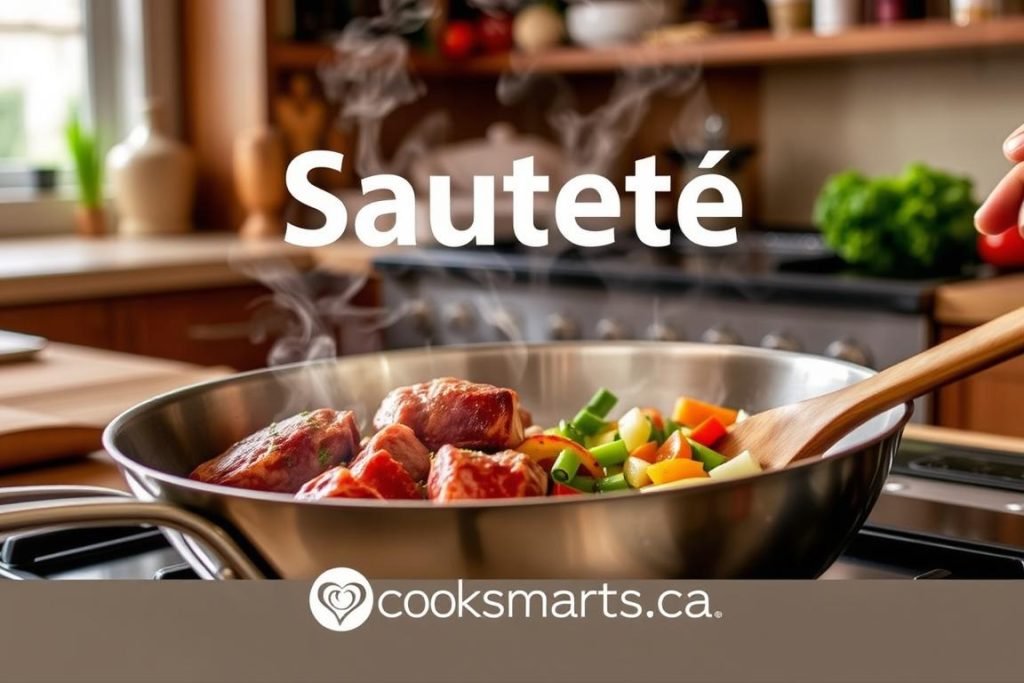
While cooking, watch the heat. If the pan smokes a lot or oil splatters, turn the heat down. Using a splatter guard helps keep your stove clean. Your skills will get better as you practice these techniques.
Keep practicing your sautéing skills. You’ll get better at pan-frying meat. Great dishes come from mastering the cooking techniques, not just following recipes.
Understanding Cooking Times and Temperatures
Getting cooking times and temperatures right is key for perfect meat doneness. High-heat cooking or working with delicate meats requires knowing the internal heat. This affects everything from the meat’s texture to its safety.
How to Measure Doneness
Measuring meat doneness can be tricky, especially with high heat. A meat thermometer is the best tool for this job. You should insert it into the meat’s thickest part for an accurate temperature. For example, red meats need to be at least 145°F. Poultry should reach 165°F to be safe to eat.
Adjusting Time for Different Cuts
Each meat cut needs its own cooking time and temperature. Thin cuts like chicken breasts cook quickly on each side. But thicker cuts, like pork chops, take longer to be safe to eat. It’s important to adjust your cooking based on the meat’s cut and thickness. This ensures both safety and quality.
Using a Meat Thermometer
Using a meat thermometer helps you cook meat safely and to your liking. It takes the guesswork out of reaching the perfect doneness. Each meat type has its own safe internal temperature. For instance, ground meats must be 160°F. Whole cuts of red meat are okay at 145°F.
Always keep these guidelines in mind when cooking. This ensures your meals are both tasty and safe. Correct temperature and timing are crucial. They make every dish from your kitchen come out exactly as you want.
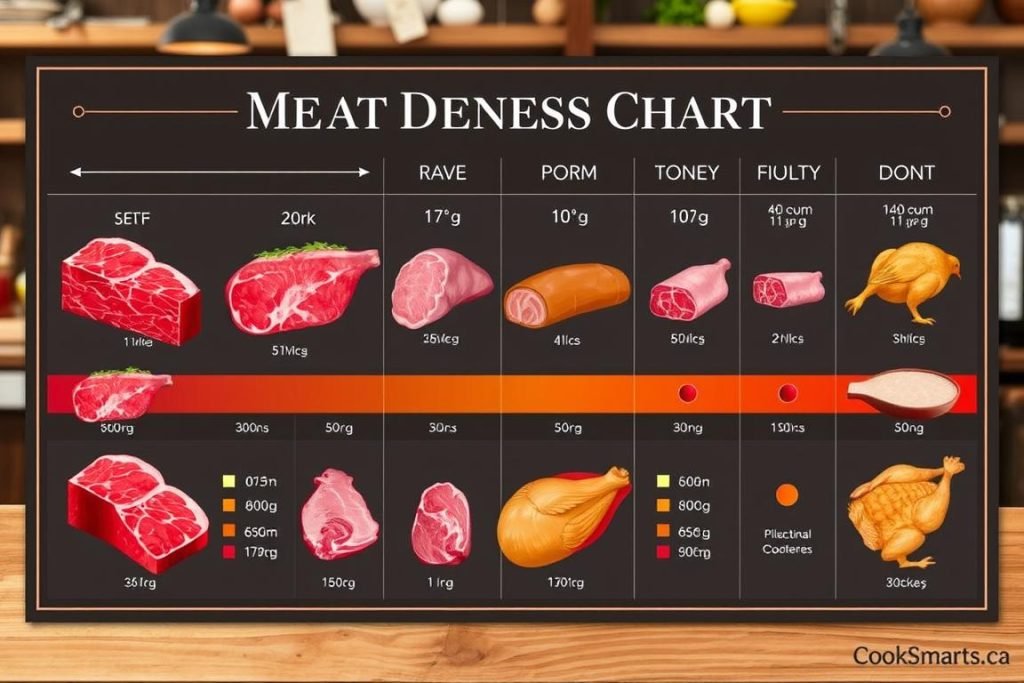
Enhancing Flavor During Sautéing
Learning how to sauté means mastering both technique and flavor. By using a mix of culinary techniques, aromatics, and sauces, the taste of your dishes will soar.
Aromatics and Herbs
Aromatics like onions, garlic, and shallots are key to enhancing flavor in sautéing. Add fresh herbs near the cooking’s end. They give meat a fragrant essence without being too strong. Garlic deepens taste, onions bring sweetness, and herbs add freshness. These elements are essential in dishes such as sautéed broccoli with garlic and lemon or a flavorful Southern Vietnamese pho.

Deglazing the Pan
Deglazing is important for unlocking flavors in your pan. Adding a liquid like wine, stock, or vinegar helps lift caramelized bits left after sautéing meat. This step cleans your pan and starts delicious sauces. Using the fond, or these caramelized bits, grabs all the savory tastes from cooking.
Adding Sauces and Accompaniments
Adding sauces and extras turns a basic sauté into a standout meal. A creamy mushroom sauce from the pan juices, or a bright chimichurri, can impress. Choosing the right sauce is all about balancing flavors—salt enhances, acid balances, and fat helps spread flavors.
| Component | Role in Flavor Enhancement | Examples |
|---|---|---|
| Salt | Enhances intrinsic flavors | Sea salt, kosher salt |
| Acid | Balances richness | Lemon juice, vinegars |
| Herbs/Spices | Adds depth and complexity | Rosemary, black pepper |
| Fat | Carries flavors, aids texture | Butter, olive oil |
| Heat | Introduces excitement, sharpness | Red chili flakes, black pepper |
By using these ideas, you can make your sautéed dishes taste amazing. Try different mixes of aromatics, liquids for deglazing, and rich sauces to find what you like best.
Common Sautéing Techniques to Master
Everyone starts somewhere in the kitchen. Mastering different sautéing techniques is a good first step. Each method can make your cooking stand out. So, knowing when and how to use them can make a big difference, whether you want crunchiness or more flavor.
Stir-Frying vs. Sautéing
It’s important to know the difference between stir-frying and sautéing. Stir-frying means cooking fast at high heat, usually in a wok. You toss ingredients to cook them evenly and keep them crisp. On the other hand, sautéing is about cooking quickly in a little oil on medium heat. It works well for tender meats or delicate foods like scallops that need a light brown crust.
Browning vs. Steaming
Browning meat gives it a rich, caramelized crust that adds lots of flavor. This is different from steaming, which keeps things moist but might make dishes look pale and less tasty. If you want depth in flavor and an appealing look, browning is the way to go in sautéing.
Flambéing: When and How
Flambéing adds excitement and a complex taste to your cooking. This technique uses a bit of alcohol, set ablaze, to bring a quick, intense heat. Use it to add a rich flavor to steaks or veggies. It’s a showstopper that also deepens the taste of your dishes.
| Technique | Primary Use | Benefits |
|---|---|---|
| Stir-Frying | Quick-cooking vegetables and small meat pieces | Even cooking, retains crispness |
| Sautéing | Chicken breast, filet mignon, scallops | Flavorful crust, quick preparation |
| Browning | Beef, chicken, pork | Enhances flavor through caramelization |
| Flambéing | Finishing meats or adding to sauces | Complex flavors, dramatic presentation |
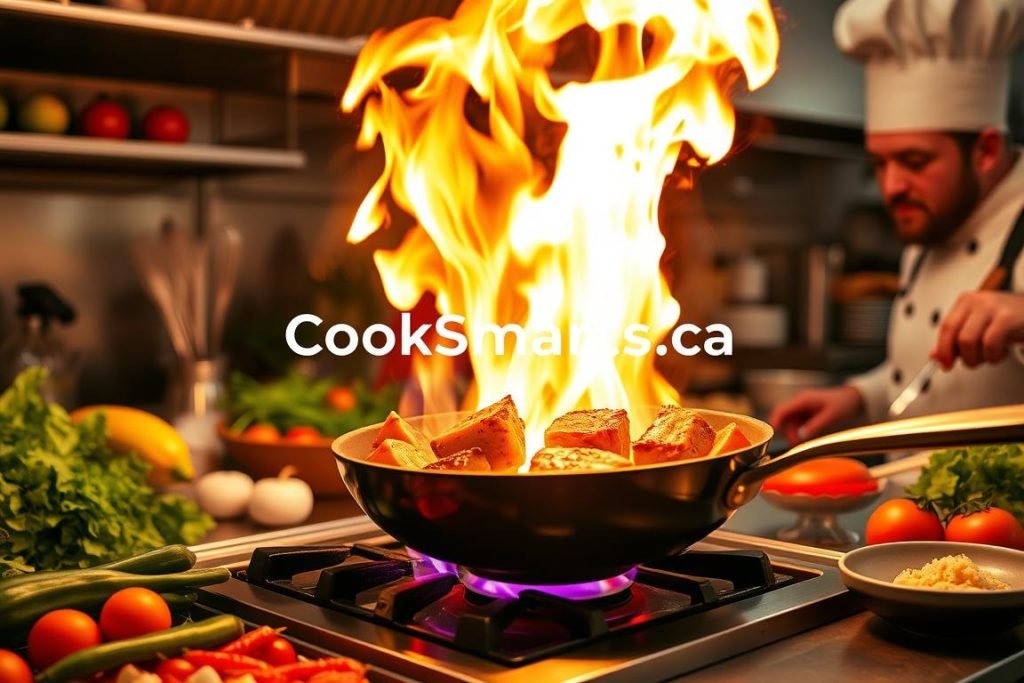
Serving and Storing Sautéed Meat
After you’ve learned how to sauté meat well, two important steps remain. These are serving and storing your dish properly. Serving it with style can make it even more appealing. As you serve, showcase the meat’s browning and caramelization. Add fresh herbs to make it look and taste great. Paying attention to how you plate the meal can have a big impact. Most recipes recommend sirloin or top-round cuts for the best taste and texture.
Presentation Tips
Your dish, with the right mix of fat and lean beef, should look enticing. Whether it’s the Sauteed Beef and Onion or your own recipe, aim to fill 75% of the plate with your meat and garnish. Adding a rich sauce can take your presentation to the next level. A sauce made from soy sauce, oyster sauce, cornstarch, water, and lemon juice works well.
Storing Leftovers Safely
Food safety is crucial when storing leftovers. Make sure to put any leftover meat into an airtight container and refrigerate it quickly. Ground beef can be kept in the fridge for up to a week or frozen for three months. When you reheat the meat, do it gently to keep it moist and evenly cooked. This ensures that the second serving is as good as the first. Following these guidelines will help you keep the nutritional value, including the calories and protein, consistent.